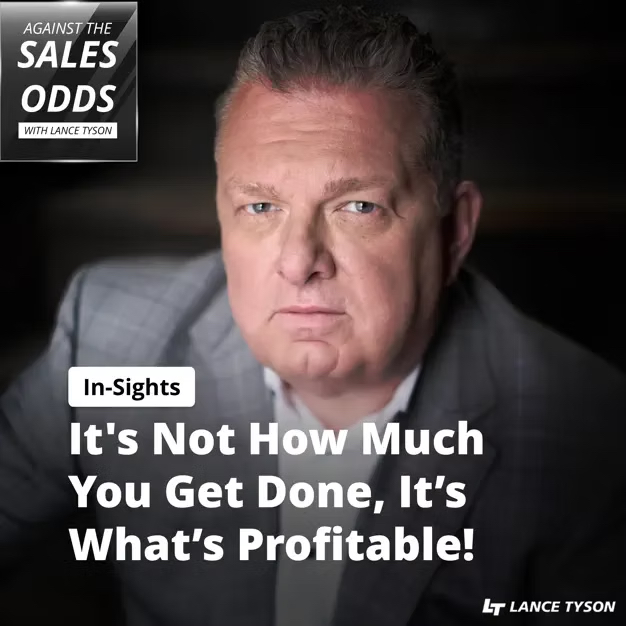What are the essential factors to consider to become a successful sales leader? Join Lance Tyson in this insightful short-form series ‘Lance Rants’ as he dives into the essential elements of effective sales leadership. Discover the keys to not only achieving success but also fostering growth within your sales team. Are you and your team reaching the desired results? Lance shares invaluable insights on cultivating successful leadership by investing in your own skills and empowering your team to excel. Tune in now and unlock the secrets to impactful sales leadership!
Lance is the bestselling author of Selling Is An Away Game and The Human Sales Factor.
You can purchase these books at: https://lancejtyson.com
Be sure to sign up for Lance’s LinkedIn newsletter here: https://www.linkedin.com/build-relation/newsletter-follow?entityUrn=7123326552678805504
—
Listen to the podcast here
Lance Rants: It’s Not How Much You Get Done, It’s What’s Profitable!
It’s Not How Much You Get Done But What’s Profitable
You are using this massive amount of time to have one-on-one. You’re having all these one-on-ones, but are you hitting your number? You only have 86,400 seconds a day. You’re not going to get any more time. What it really comes down to is profitable action. It’s not how much you get done. It’s what’s profitable. You have to feel the best players.
It’s like leads. Do you guys get leads every once in a while? How do you give leads out? Do you share them equally or are you socialist? Are we a socialist utopia? Give leads out. Let’s give them out. Everybody should get the leads. You’re like, “What are you? A charity?” I give leads to players. If we’re in bad shape, I need the hitter-up. You’re like, “That’s not fair.” That is fair. That’s not equal. 3rd liners do not get 1st-liner time ever. You’re like, “That’s not fair. They score more goals because they’re out.” When I put them out, they score. You ask, “How do I get there?” Figure out how to be a first liner. Maybe you should have skated more[1].
I’m very public about who gets the leads too. They never figure it out. I’ll be like, “We got three leads that came in this week. This is all going to you.” You might be like, “What do you mean? The guy’s appointments were off the charts for the last three weeks. His closing ratio is higher than everybody’s. His pipeline is 3x. That’s not fair.” That is fair. That’s not equal. You’re like, “He’s going to even sell more.” I go, “I know. It sucks, doesn’t it?” You then might be like, “I’m going to have a bunch of people that will complain.” I go, “Complain. Good luck.”
I might change it up and then spread it across. I get all your automation systems and stuff like that. Screw around with it a couple of times. Remember. Sometimes, you need to turn the heat up. There are all kinds of ways to turn heat up. Sometimes, you might want it cold because frigid causes action too. When you start getting cold, you’re like, “How do I get warm? What do I need to do to get warm here?” That causes action too.
Achieving Desired Results
I’m throwing some stuff at you. My job in 45 minutes is to get your perspective to change. Is that fair? Let me show you a couple of thoughts here. In sales leadership, your job is the ability to enlist the willing cooperation of people to achieve desired results. Is that fair? Why does your job exist? That’s not in any order. It could be to build people and get results in the flip-flops all the time. You three are there under Derek to get results.
Let me show you how org charts work. Results aren’t there at a board meeting or senior leadership meeting. They’re looking at income and revenue. There’s then a conversation right at Grissom’s level with people. That starts rolling into Derek and then Derek rolls into you, and then you roll into your people. That’s the progression of gravity.
If you look at the inside sales team, I’m pretty sure that Derek didn’t put an inside sales team together to develop careers inside pro sports. That would be very utopian of him. You are like, “We’re in broken careers.” No. You’re getting results too. This is not like Goger results. That’s why it’s there. It’s why you’re spending so much money on these people. It’s to get results. That’s why your job exists. Is that fair enough?
Where you got to be is not just to take the temperature, but you need to set the temperature. It’s the difference between a thermostat and a thermometer. The thermostat takes temperature and sets the conditions in the environment that are necessary. As you look at where you spend your time, how you’re developing people, and how you’re communicating with people, are your meetings set up to take a temperature? You have to decide that here.
You have to understand what motivation is. You might need to create a motivational environment. Anger and competition are motivators. I’m pretty sure looking at all three of you and looking at your LinkedIn profiles that there have probably been plenty of times that you’ve moved up the ranks because you were flat-out pissed off. Anger’s not sustainable. I’m not saying cheating, but let’s move the needle. What’s the difference between that word and that word? Do you want to be known as a manipulator? You’re all wrong. You do. You don’t understand.

Sales Leadership: Create a motivation environment. Anger and competition are motivators.
Motivation Vs Manipulation
The thin line between motivation and manipulation is in the definition. In motivation, moti in Latin means for within. In manipulation, mani means hand. It’s manual. One of the definitions of the word manipulation is to act in a skillful manner. I believe it’s the second definition. Do you think you’re purely motivating when you run a contest? Wake up. You’re manipulating.
The thin line between motivation and manipulation is in the definition.
My dad was an excavator. I worked labor from the time I was 12 until I was 24, so I do what I do. My dad used to yell at me with the shovel and everybody that worked for him. You couldn’t lean on the shovel. We’d cut them so that they weren’t really short shovels because you’d have to go down to lean on them. He didn’t want people to lean on shovels. He wants you to work.
He would always say, “Are you going to manipulate the shovel or is this shovel going to manipulate you? Get a hole. Fill up the shovel. It’s not half a shovel load. It’s a full shovel load. It’s the same with a wheelbarrow. Are you going to manipulate the wheelbarrow or is it going to manipulate you? You need to know how the wheelbarrow works. You have to load it evenly. You have to spread it across. You need to know where the dump part is. You can get a little high there so it’s easier to get up at the end and it pulls down the front. That’s the difference.”
There is a dark definition of manipulation, but I’m not talking about that where you’re actively trying to hurt somebody, be nefarious, and things like that. That’s not what I’m talking about here. I’m talking about acting in a skillful manner. What motivates your people? If you go to Maslow and want to understand motivation, if people don’t, at some level, worry that somebody may take their job or that they’re replaceable, then salespeople get adaptive[2]. Salespeople get lazy. You can’t even afford it.
The manufacturing company I am working with, I had their VP start marching people in the interview in front of everybody. He goes, “We’re not hiring.” I go, “You’re always hiring.” He goes, “Why would I do that?” I go, “Why wouldn’t you march a bunch of people in here? You got a bunch of salespeople that have been here for fifteen years and make gobs of money. They’re not hitting their performance standards and they think they’re irreplaceable. Why don’t you start marching people on and interviewing them?” He goes, “I don’t think it’ll work.” I go, “I’ll bet you $1,000 it works. I’ll take it off my bill, but you have to do exactly what I’m telling you to do. Plus, you’re going to find some good people.”
He started it once a week with 2 or 3 people right after the sales meeting. People were like, “Who are these people?” He was like, “We’re interviewing them.” They were like, “For what? There are no openings.” He was like, “No. There are always openings for sales. We have a feeling some people might leave, so we’re interviewing them.” Some people wake up. All of a sudden, they’re like, “Is my job okay?” Do you think your job’s not okay?
You can play it any way you want, but you have to understand this. Have you created such an environment that people aren’t looking over their shoulders? With what you guys should be playing, you have the perfect system if you think about it philosophically. Our inside sales team, even if they’re not ready, they need to be ready to go.
It’s not a time thing either. If you’re sitting there going, “They have to be here for 8 or 9 months.” The whole system of inside sales when it was created by Scott O’Neill and Chad, which are the earliest versions of inside sales, was created to be a brush fire that this group here presses on the groups above them, like account execs which presses on the group sales or however you hit.
I argue all the time to go outside. For instance, if Matt’s group has an opening, you should never go outside. You should immediately pull from inside sales whether they’re ready or not. Why take somebody else’s trash? Plug them in because that’s what it’s for. It’s a moneyball system. If you play it correctly, you pressure the other groups because they’re looking at the bottom two tiers of Maslow’s hierarchy of needs and going, “Somebody can replace me.” It doesn’t matter if they’re ready or not. Plug right back in and move. That’s why it was originally created.
What’s happened over the years is sales managers got to this point that they’re slow playing the inside team and are like, “They’re not ready.” You should have your 4 or 5 people. You guys should all be in agreement like, “Here are the 4 or 5 people that come out of inside sales. Madison, you got to be completely okay with these guys taking your top person. At the end of the day, you’re triple-A, and then there are juniors and pros.” It’s a movement because you want to create an environment where everybody is looking over their shoulder. You don’t want them to be comfortable.




